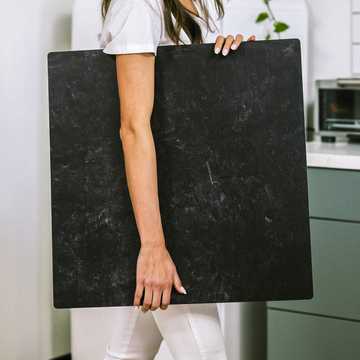In the world of product photography, we often find ourselves chasing the next expensive piece of gear, convinced it holds the key to better images. Yet after 15+ years behind the camera, I've discovered that some of the most powerful tools in my arsenal are surprisingly humble. Case in point: the whiteboard-an unassuming office staple that has become one of my secret weapons for creating scroll-stopping product photos.
Why Your Studio Needs a Whiteboard (And Not Just for Brainstorming)
When I mention using whiteboards in my photography workshops, I'm typically met with confused looks. "Don't you mean foam core?" they ask. While white foam core certainly has its place, a proper whiteboard offers distinct advantages that make it worth finding space in your studio.
The Science Behind the Shine
What makes whiteboards special is their unique reflective properties. Unlike foam core's completely matte finish, a quality whiteboard features a semi-gloss surface that reflects light in ways that can transform your product photography:
- Superior Reflectance: With 85-92% light reflection across the visible spectrum, whiteboards return more light to your subject than many DIY alternatives
- Controlled Specularity: The semi-gloss surface adds a subtle dimensionality to products that flat matte reflectors simply can't achieve
- Color Temperature Preservation: Whiteboards maintain neutral reflection, preventing the unwanted color shifts that can occur with improvised reflectors
I discovered this accidentally while photographing a collection of luxury watches. The direct lighting created harsh reflections in the crystal, but placing a whiteboard at a specific angle not only eliminated the problem-it actually enhanced the watches' dimensional curves better than any other reflector in my studio.
Creative Techniques You Won't Find in Photography 101
The "Whiteboard Corridor" Technique
One of my favorite setups for challenging subjects like perfume bottles or cosmetics packaging is what I call the "whiteboard corridor." Here's how it works:
- Position your product on your shooting surface
- Place whiteboards on both sides of the product, angled at approximately 45 degrees
- Add a third whiteboard above, angled down toward the product
- Aim your key light at one of the side whiteboards rather than directly at the product
This creates a controlled light environment that wraps soft, dimensional light around your product while minimizing problematic reflections. The results are particularly stunning for items with mixed textures (think matte packaging with glossy labels or cosmetics with metallic details).
Controlled Reflection Mapping
Here's a technique few photographers discuss: using marked whiteboards to create intentional reflection patterns. By drawing subtle grid lines or patterns using a light gray marker on your whiteboard, then positioning it to reflect in glossy products, you can create distinctive catchlights that define product contours.
This works beautifully for jewelry, glassware, and electronics-adding visual interest without the overwhelming reflections that mirror reflectors create. I've used this technique on everything from wedding rings to premium headphones, creating signature lighting effects that clients specifically request.
From Background to Canvas
Beyond reflection control, whiteboards offer unique shooting surface capabilities:
- Real-Time Composition Marking: Draw alignment guides directly on the board for perfectly positioned flat-lays or consistent product series
- Adjustable Background Gradients: Angle a whiteboard under proper lighting to create smooth gradients from pure white to light gray
- Heat-Resistant Surface: Unlike some plastic surfaces that warp under hot studio lights, quality melamine whiteboards maintain their shape
Practical Implementation for Real-World Photographers
Whether you're a full-time professional or side-hustling solopreneur, here's how to integrate whiteboards into your workflow:
Choosing the Right Board
Not all whiteboards are created equal for photography purposes:
- Size: 24"×36" offers versatility for most product photography while remaining manageable
- Surface: Look for premium melamine surfaces rather than budget options that may have uneven reflective qualities
- Frame: Frameless or thin-framed boards prevent unwanted edge shadows in your setups
- Mounting: Consider adding simple mounting holes to enable suspension for overhead setups
Budget-Friendly Alternatives
If a new whiteboard isn't in your budget, check online marketplaces for used office supplies. Schools and businesses regularly upgrade their whiteboards, making second-hand options both affordable and environmentally friendly. I found three of my current boards this way, paying less than $40 total for what would have cost hundreds new.
Real Results: Before and After
Recently, I was struggling with a particularly challenging shot of crystal glassware for a client. The direct lighting approach created harsh hot spots, while standard diffusion killed the sparkle that makes crystal special.
By implementing a whiteboard reflection system, I achieved the perfect balance: dimensional highlights that maintained the crystal's brilliance while eliminating distracting reflections. The client was thrilled, never suspecting that the solution came from office supply store rather than expensive photography gear.
Beyond Photography: Dual-Purpose Studio Organization
For those working in limited space, whiteboards pull double duty. The same board that perfects your product lighting can also track your shooting schedule, client deadlines, or content calendar when not in use. This kind of efficiency is particularly valuable for solo creators juggling multiple roles.
I've actually color-coded one of my boards-one side remains pristine white for photography use, while the reverse side is covered in my shooting calendar, equipment maintenance schedule, and client contact information.
Final Thoughts: Mastery Through Creative Problem-Solving
The humble whiteboard exemplifies what I believe is the true spirit of professional photography: finding extraordinary potential in ordinary objects. While there will always be a place for specialized equipment, true photographic excellence comes from creative problem-solving and understanding the physics of light-not just having the most expensive gear.
Next time you're facing a lighting challenge in your product photography, before reaching for your credit card to buy another specialized tool, consider whether that office whiteboard might just hold the solution you need. Your images-and your budget-will thank you.
What unexpected tools have you incorporated into your photography workflow? Share your creative hacks in the comments below!



